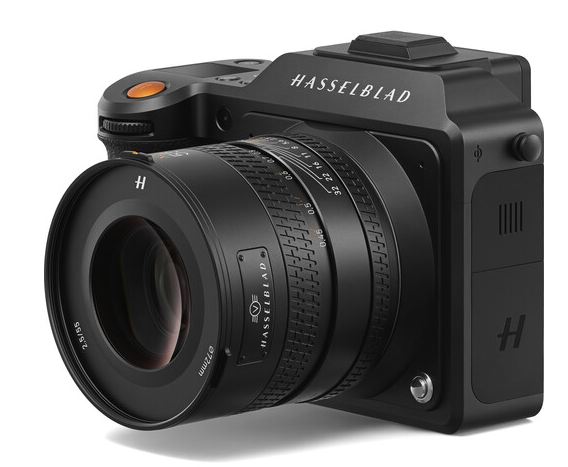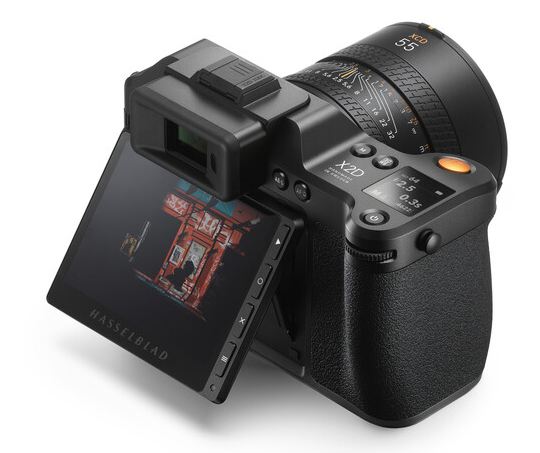
Hasselblad X2D 100C – finally announced. The camera uses the same sensor we have seen the Fuji GFX 100. The pixel count of the sensor is 11,656 x 8742 (almost 102MP). The camera is able to capture 16-bit files with 15 stops of dynamic range. The X2D’s ISO range runs from 64–25,600. AF speed by 66% over the X1D II 50C. The Hasselblad X2D 100C features 294 phase detection points across 97% area of the sensor. X2D offers up to 7 stops of stabilization, so literally, it will allow you to handheld shooting at shutter speeds for as long as one second.
Hasselblad X2D features built-in 1TB SSD – 4004 Raw+JPEG images, 5331 Raw files, or a cool 16,000 JPEGs. Having a dual card slot always helps in case of card failure while attending a pro event, so I hope Hassy also allows us to have an online backup or something similar to that for more secure shooting.
The Hasselblad X2D 100C is available starting today through Hasselblad’s shop for €8,699 / £7,369 / ¥54,900 including VAT and $8,199 excluding sales tax.
Get Hasselblad X2D 100C from B&H Store

Hasselblad X2D 100C Press Release
Hasselblad Launches New Flagship Camera and Three All-New Lenses
Introducing the X2D 100C, XCD38V, XCD 55V and XCD 90V
After the groundbreaking success of the X1D-50c and its second iteration, the X1D II 50C, Hasselblad unveils the powerful X2D 100C, along with three new lenses to the XCD family, the XCD 2,5/38V, XCD 2,5/55V, and the XCD 2,5/90V, providing the ultimate experience for content creators. Hasselblad X2D 100C – Inspiration in Every Detail Hasselblad’s next-generation mirrorless medium format digital camera, the X2D 100C, has been engineered to bring substantial technological enhancements to image quality, camera handling, and system responsiveness. Designed in a new dark grey tone body of machined aluminium, the X2D 100C houses a 100-megapixel back-side illuminated (BSI) (43.8 × 32.9 mm) CMOS sensor, delivering up to 15 stops of dynamic range with a 16-bit colour depth. The X2D 100C enables a creative experience unimaginable in the past. It empowers content creators to capture the intricacies of an image’s highlights and shadows, utilising the Hasselblad Natural Colour Solution (HNCS). Working alongside the new 5-axis, 7-stop in-body image stabilisation system (IBIS), handheld image capture is possible in the widest range of conditions. Hasselblad independently developed its own IBIS for the X2D 100C in order to meet the stringent requirements for stabilising a 100MP sensor. Keeping size and weight in mind for easy portability, the X2D 100C is the most compact medium format IBIS solution on the market.1
With 294 Phase Detection Autofocus (PDAF) zones, the system ensures the subject is rapidly located and brought into focus. The X2D 100C captures files in 3FR RAW and full-size JPEG, and the cutting-edge, built-in 1TB SSD storage and CFexpress Type B card support delivers a high capture rate for fast-moving subjects.
The X2D 100C features an 0.5-inch OLED Electronic Viewfinder (EVF) with 5.76-million dots, a high magnification of 1.00x with a refresh rate of 60fps, which supports electric refractive error correction to ensure the whole display is sharp and bright, from corner to corner.2 A 1.08-inch colour top display and a 2.36MP, 3.6-inch tilting, touch-capable rear display delivers access to all of these new imaging technologies whilst keeping the intuitive Hasselblad User Interface (HUI) and Scandinavian style of the X System. The battery has a CIPA rating of 420 shots and supports PD 3.0 fast charging.3 Additionally, the X2D 100C is compatible with Phocus, Hasselblad’s free image processing software.
“When developing the X2D 100C, our goal was the same as always, just as Victor Hasselblad himself made decades ago: build a better camera,” said Bronius Rudnickas, Hasselblad Marketing Manager. “This commitment drives us to explore the possibility to improve its performance from all aspects.”
¹ Among interchangeable-lens mirrorless digital cameras with a 55mm-diameter CMOS sensor (according to a Hasselblad market survey on 1 March, 2022).
² Magnification: approximately 1.00x with the XCD 65 at infinity, –1 m-1.
³ To charge via PD protocol, the charging cable and power source must be PD-compatible.






